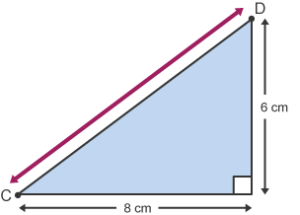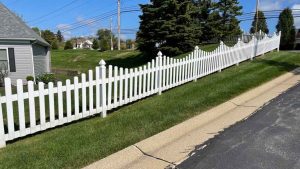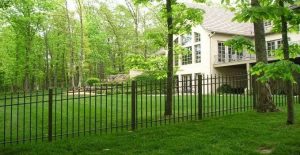
How to Install Vinyl Fence on a Slope | 10 Easy Steps
Learn how to handle slopes and make a strong, cool-looking vinyl fence that lasts long.
Ready to upgrade your yard with an easy setup? Keep reading for pro tips and clear steps on setting up a vinyl fence on a slope. Also
Read Aluminum Fence Cost Guide | Factors, Materials, and Installation
1. Assess the Slope Gradient

When installing a vinyl fence on a slope, the slope gradient of your property, post hole, and bottom rail play a crucial role. Use a level to measure the angle accurately, ensuring precise assessment. The degree of slope will significantly impact how you approach the installation process.
To effectively install a vinyl fence on a sloped terrain, understanding the challenges posed by the slope is essential. It may require employing techniques like stepping or adjusting the fence panels to fit the contour of the land. Properly assessing the slope at the outset helps in planning and executing the installation seamlessly.
2. Choose Adjustable Fence Panels
When installing a vinyl fence on a slope, it is crucial to opt for fence panels that offer adjustability. Look for panels specifically designed to cater to sloped terrains, allowing for both height and angle adjustments.
Flexibility in the panels is key to ensuring they can seamlessly follow the contour of the slope, providing a neat and secure installation that conforms to your property’s landscape.
By choosing adjustable fence panels, you can easily navigate the challenges posed by uneven terrain while adhering to local zoning laws regarding fence installations.
3. Measure Post Heights
When installing a vinyl fence on a slope, measuring post heights accurately is crucial. The posts need to be adjusted based on the slope gradient to maintain a consistent fence height. Ensure that the post heights are uniform to avoid an uneven installation.
Double-checking the measurements will help in achieving a visually appealing and structurally sound fence.
Measure post heights according to the slope gradient.
-
Adjust post heights for uniformity.
-
Double-check measurements to prevent inconsistencies.
By following these steps diligently, you can achieve a sturdy and visually pleasing fence that complements your landscape effortlessly.
4. Install Posts at Correct Angles

When installing a vinyl fence on a slope, position the posts at angles that correspond to the slope gradient. This ensures proper alignment and support for the fence structure. Secure the posts firmly into the ground to maintain stability on the sloped surface.
Properly aligning the corner posts, line posts, and end posts is crucial for the fence’s overall integrity. Use a post hole digger to create adequate holes for each post, considering the specific post locations based on the slope of the terrain. Ensuring that all posts are installed correctly will prevent issues with the fence’s durability and appearance.
5. Use Gravel for Stability
Utilizing a gravel base in your vinyl fence installation on a slope is crucial for ensuring both drainage and stability. The gravel helps in preventing post shifting, especially on uneven terrains. By selecting the appropriate type and quantity of gravel, you can significantly enhance the longevity and durability of your fence.
Properly compacting the gravel at the base of the post holes further reinforces the structural integrity of the entire fence system. This step not only provides stability but also aids in maintaining the alignment of the posts, crucial for the overall aesthetics and functionality of the fence.
Gravel base offers drainage and stability.
-
Correct type and amount prevent post shifting.
-
Proper compaction enhances structural integrity.
Gravel base offers drainage and stability.
Correct type and amount prevent post shifting.
Proper compaction enhances structural integrity.
6. Adjust Panel Heights
Adjusting panel heights is crucial when installing a vinyl fence on a slope to ensure a seamless and uniform look. Maintaining consistent fence height across panels is essential for both aesthetics and functionality.
Customize each panel’s height to accommodate the sloped terrain effectively.
-
Use appropriate tools like saws or trimmers to make precise adjustments.
-
Ensuring that the panels are properly adjusted will not only enhance the appearance of your fence but also contribute to its structural integrity.
Customize each panel’s height to accommodate the sloped terrain effectively.
Use appropriate tools like saws or trimmers to make precise adjustments.
Ensuring that the panels are properly adjusted will not only enhance the appearance of your fence but also contribute to its structural integrity.
7. Secure Panels with Brackets
When installing a vinyl fence on a slope, secure the fence panels using brackets attached to the posts. Place the brackets strategically along the bottom rail to ensure proper support for the panels. Adjust the brackets as necessary to maintain alignment and stability.
Install brackets at suitable intervals to support the panels effectively.
-
Check the alignment of the panels and adjust the brackets as needed.
Install brackets at suitable intervals to support the panels effectively.
Check the alignment of the panels and adjust the brackets as needed.
Proper careful planning is crucial when securing fence panels with brackets on a slope. Ensure that the brackets are firmly attached to provide adequate support for the fence structure. By following this method, you can create a sturdy and visually appealing vinyl fence even on uneven terrain.
8. Trim Excess Panel Length
Trimming the length of fence panels is crucial when installing a vinyl fence on a slope. This step ensures a proper fit and a visually pleasing appearance. Use a saw or cutting tool to accurately customize the panel length according to the slope’s requirements.
Trim any excess material carefully to avoid uneven edges.
-
Measure multiple times before cutting to prevent errors.
-
Smooth out any rough edges post-cutting for a polished look.
Trim any excess material carefully to avoid uneven edges.
Measure multiple times before cutting to prevent errors.
Smooth out any rough edges post-cutting for a polished look.
9. Check Fence Alignment
Ensure the fence panels are aligned correctly by using a level to check for straightness and parallel positioning. Making necessary adjustments is crucial to maintain the fence’s integrity and aesthetics.
Confirm that the fence follows the natural slope gracefully, blending seamlessly with the landscape. By aligning the fence properly, you not only enhance its visual appeal but also ensure its structural stability.
Checking the alignment is essential to avoid any future issues with the fence line and maintain consistency along your property line.
Verify fence panel alignment with a level.
-
Adjust panels to be straight and parallel.
-
Ensure the fence flows naturally with the slope of your property.
Verify fence panel alignment with a level.
Adjust panels to be straight and parallel.
Ensure the fence flows naturally with the slope of your property.
10. Maintain Consistent Panel Gaps
To achieve a visually appealing vinyl fence on a slope, maintain consistent panel gaps throughout the installation process. This attention to detail enhances the overall aesthetics and ensures a professional finish.
Utilize spacers to guarantee uniform spacing between the fence panels, preventing any irregularities along the fence line. By regularly checking and adjusting the panel gaps, you can address any discrepancies promptly and maintain a cohesive appearance across the entire fence structure.
Consistent panel gaps not only contribute to the visual appeal of your vinyl fence but also play a crucial role in its longevity and durability. Properly spaced panels help distribute wind load evenly, reducing stress on individual sections and enhancing the fence’s overall stability.
Final Remarks – Install Vinyl Fence on a Slope

To install a vinyl fence on a slope, follow these steps: check the slope, use adjustable panels, set the right post angles, add gravel for stability, adjust panel heights and alignment carefully, secure panels with brackets, trim excess lengths, and keep gaps consistent.
By following these steps, you can have a strong and good-looking fence. It will make your property look better and last longer.
Also Read How to Seal a Fence | Step-by-Step Guide
FAQs – Install Vinyl Fence on a Slope

